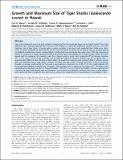Growth and maximum size of tiger sharks (Galeocerdo cuvier) in Hawaii
Abstract
Tiger sharks (Galecerdo cuvier) are apex predators characterized by their broad diet, large size and rapid growth. Tiger shark maximum size is typically between 380 & 450 cm Total Length (TL), with a few individuals reaching 550 cm TL, but the maximum size of tiger sharks in Hawaii waters remains uncertain. A previous study suggested tiger sharks grow rather slowly in Hawaii compared to other regions, but this may have been an artifact of the method used to estimate growth (unvalidated vertebral ring counts) compounded by small sample size and narrow size range. Since 1993, the University of Hawaii has conducted a research program aimed at elucidating tiger shark biology, and to date 420 tiger sharks have been tagged and 50 recaptured. All recaptures were from Hawaii except a single shark recaptured off Isla Jacques Cousteau (24 degrees 13'17 '' N 109 degrees 52'14 '' W), in the southern Gulf of California (minimum distance between tag and recapture sites = approximately 5,000 km), after 366 days at liberty (DAL). We used these empirical mark-recapture data to estimate growth rates and maximum size for tiger sharks in Hawaii. We found that tiger sharks in Hawaii grow twice as fast as previously thought, on average reaching 340 cm TL by age 5, and attaining a maximum size of 403 cm TL. Our model indicates the fastest growing individuals attain 400 cm TL by age 5, and the largest reach a maximum size of 444 cm TL. The largest shark captured during our study was 464 cm TL but individuals >450 cm TL were extremely rare (0.005% of sharks captured). We conclude that tiger shark growth rates and maximum sizes in Hawaii are generally consistent with those in other regions, and hypothesize that a broad diet may help them to achieve this rapid growth by maximizing prey consumption rates.
Citation
Meyer , C G , O'Malley , J M , Papastamatiou , Y P , Dale , J J , Hutchinson , M R , Anderson , J M , Royer , M A & Holland , K N 2014 , ' Growth and maximum size of tiger sharks (Galeocerdo cuvier) in Hawaii ' , PLoS One , vol. 9 , no. 1 , e84799 . https://doi.org/10.1371/journal.pone.0084799
Publication
PLoS One
Status
Peer reviewed
ISSN
1932-6203Type
Journal article
Description
The authors acknowledge the National Oceanic and Atmospheric Administration (National Marine Sanctuaries Program), University of Hawaii Sea Grant and the State of Hawaii (Department of Land and Natural Resources) for providing funding to support a variety of shark research projects that collectively made this study possible.Collections
Items in the St Andrews Research Repository are protected by copyright, with all rights reserved, unless otherwise indicated.

